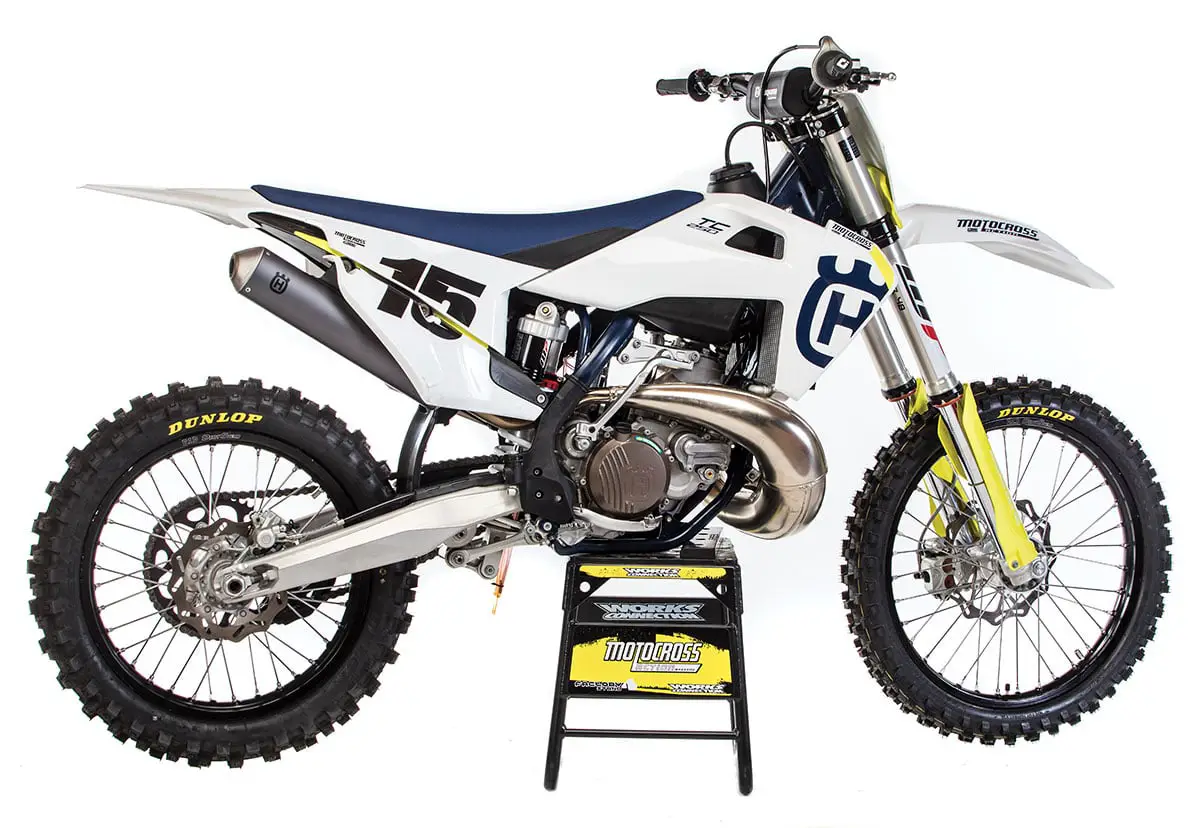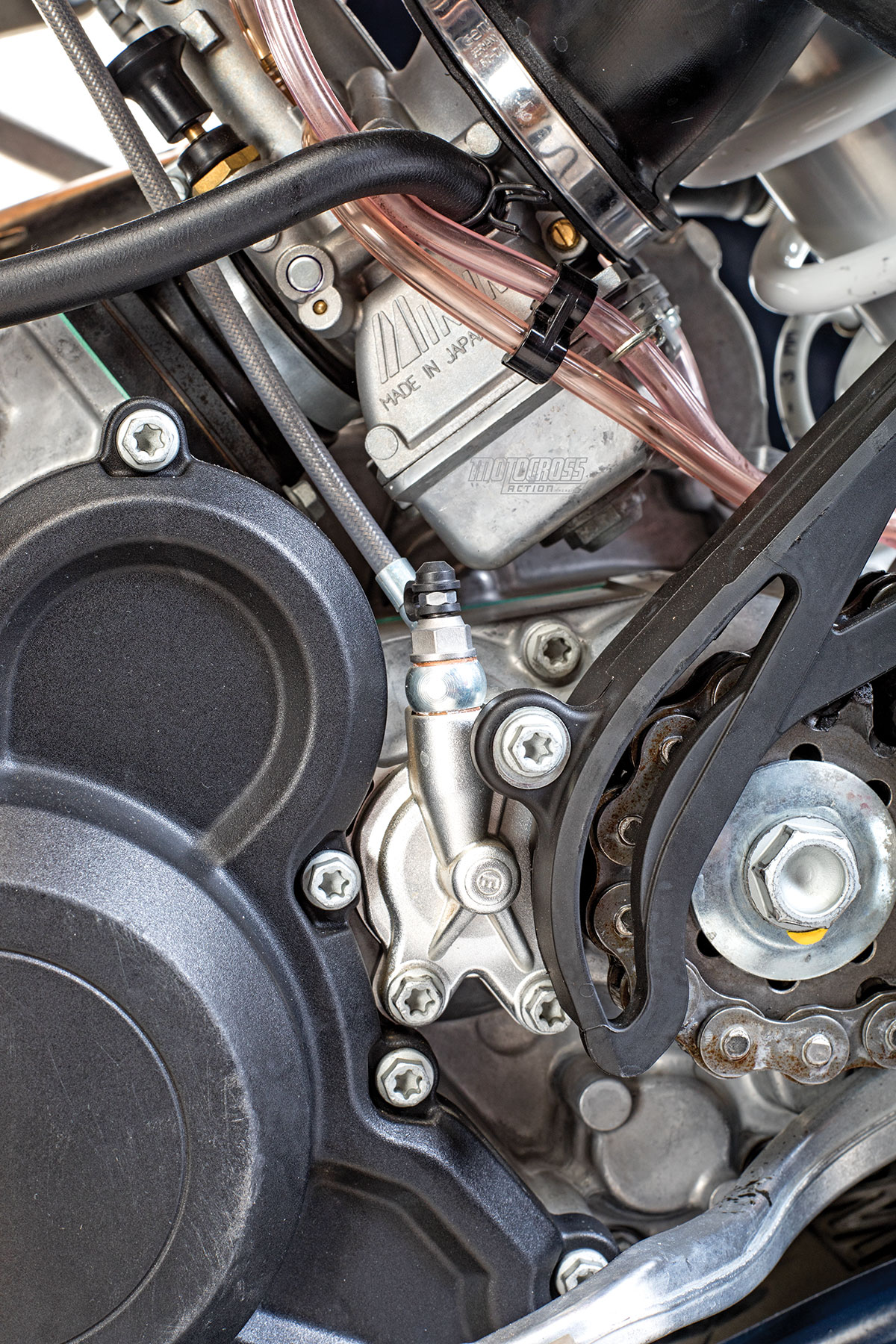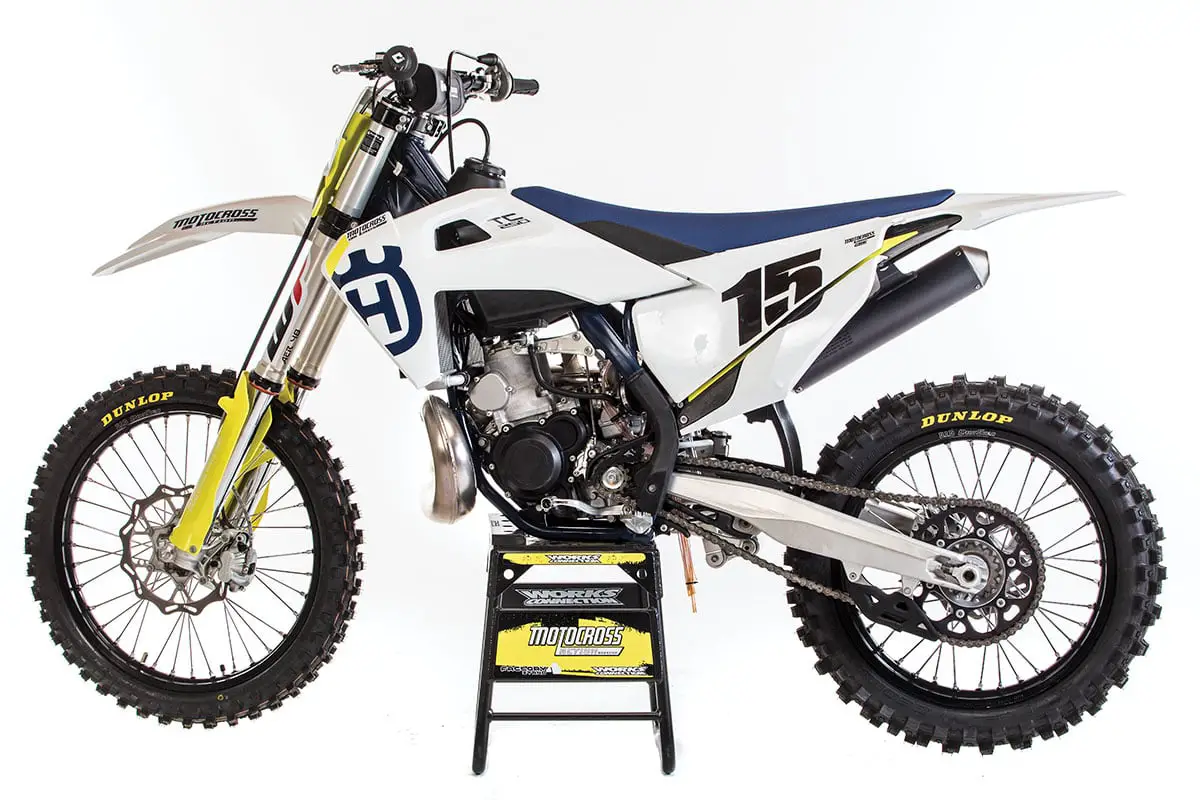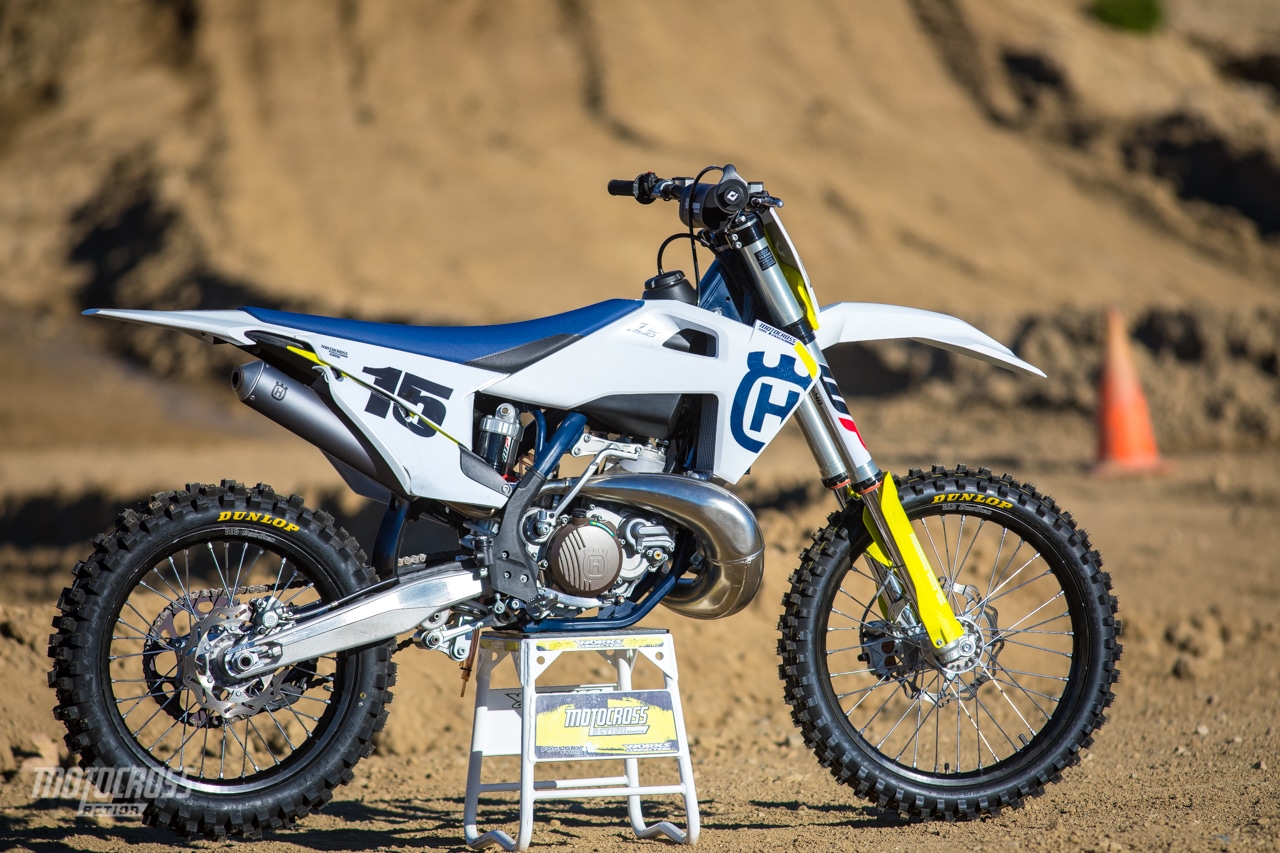MXA RACE TEST: 2019 HUSQVARNA TC250 TWO-STROKE

Q: FIRST AND FOREMOST, IS THE 2019 HUSQVARNA TC250 BETTER THAN THE 2018 TC250?
A: Yes, but it shares some of the finery, flaws and foibles of the older one.
Q: WHAT DOES THE HUSQVARNA TC250 COST?
A: The 2019 Husqvarna TC250 costs $100 more than it did in 2018 and $500 more than in 2017. Worse yet, the 2019 TC250’s $8299 price tag is $900 more than the 2019 Yamaha YZ250 two-stroke’s $7399 sticker price.
Q: HOW DOES IT RUN ON THE TRACK?
A: Compared to its brother-in-law, the KTM 250SX, the 2019 Husqvarna TC250 could be considered the tamer relative in the family. That would normally be a big negative, but given the aggressive way the 66.4mm x 72mm bore-and-stroke engine of the KTM 250SX delivers its power, the tamer delivery of the TC250’s powerplant can make the Husky more manageable. If you expect a 250cc two-stroke to explode in the middle and rev until the cows come home, that isn’t the TC250’s modus operandi. This is a kinder and gentler two-stroke. The power is at its best from low to mid. After that, there is an acceptable, albeit abbreviated, top-end rush. In back-to-back tests against the 2019 KTM 250SX, the two powerbands felt very different. The KTM’s output was livelier, hit harder and rushed through its spread, while the Husky TC250 was more controlled and metered.
In a lot of ways, the TC250 bridges the gap between the 250SX and YZ250 powerbands. The 250SX is all about explosive power now (and not much later), while the YZ250 is a deferred-gratification powerplant that starts mellow and saves its punch for higher in the rpm range. That leaves the 2019 Husky TC250 as the go-between. It’s not as violent off the bottom as the KTM 250SX and not as high revving as the Yamaha YZ250. It is a lot like Baby Bear’s porridge.
If we had our druthers, we think that the perfect powerband would be the KTM 250SX’s low-to-mid power mated to the Yamaha YZ250’s top-end. Don’t mistake our desire for more power on top as a negation of what the 2019 Husqvarna TC250 is capable of. This is still a fast 250cc two-stroke, and, for the vast majority of riders, the path that Husky went down (somewhere between the low road of the KTM and the high road of the Yamaha) is just about perfect for riders who are scared by the orange bike’s bark and unimpressed with the blue bike’s muted roll-on. Although the 2019 Husqvarna TC250 is a clone of the KTM 250SX two-stroke, it is a kinder, gentler 250cc motocross bike. It makes the same peak horsepower, but doesn’t hit as hard.
Although the 2019 Husqvarna TC250 is a clone of the KTM 250SX two-stroke, it is a kinder, gentler 250cc motocross bike. It makes the same peak horsepower, but doesn’t hit as hard.
Q: CAN YOU TURN A TC250 INTO A 250SX?
A: With the exception of a few pieces, the TC250 is a 250SX—with the power delivery as the major difference. If you want your 2019 Husqvarna to run just like a 2019 KTM 250SX, the solution is simple. Husqvarna’s two-piece plastic airbox is more like a time capsule than a supply pool for an engine’s most important element. That’s not to say that the KTM’s airbox couldn’t stand to breathe a little better, but at least it does breathe—as proved by its brisker power delivery. You may not believe that drilling holes in the Husqvarna’s airbox cover will produce snappier throttle response and better power linkage from low to top, but the Rockstar Husqvarna factory team does. They drill their airboxes. MXA drills its airboxes. You can prove it to yourself by removing your TC250’s airbox cover and riding the bike for a few minutes without it on. After that test ride, you will break out your drill and crack open the time capsule to let the air out.
Q: WHAT ABOUT THE JETTING?
A: It took Husqvarna two years to get the jetting on the 38mm Mikuni TMX carb right and the 2019 jetting is in the ballpark. Obviously, there will be some air-screw, needle or pilot adjustments needed for your local elevation, humidity and temperature. It should be noted that Husqvarna’s owner’s manual wants TC250 owners to run their fuel mixture at a 60:1 ratio. The MXA wrecking crew was reluctant to change from our preferred 40:1 Maxima mixture, but we set up a special fuel test at the track and ran both ratios with the stock brass in place. Surprise! The 60:1 ratio ran crisper and cleaner than the 40:1. So, we did what Husqvarna asked; however, we understand how tight the bond is between a racer and his favorite fuel/oil mixture, so if you don’t want to switch, stick with your personal favorite and fiddle with the brass to get it to work.
Q: WHAT ABOUT THE GEARING?
A: Given that the Husqvarna TC250 is essentially a low-to-mid powerband with peak power at around 8200 rpm, you can’t depend on high-rpm rev to get you to the next corner. You have to shift, whether you want to or not. In a way, the stock 14/50 gearing is a conundrum. The stock gearing does help magnify the power output from gear to gear—if you shift on the bubble; however, the bubble is very low in the rpm range. Our solution is to gear the 2019 Husqvarna TC250 one tooth taller. Swap the 50-tooth rear sprocket for a 49-tooth rear. The taller gearing will smooth out the power delivery, lengthen the gap between gears and make the engine feel like it pulls further in the rpm range, thus requiring the rider to shift less.
Q: HOW DO YOU ADJUST THE POWER VALVE?
A: Husqvarna’s power valve is adjustable with a Robertson wrench. The power valve is held in the closed position by a spring. You can change when the power valve opens by adjusting preload on this spring. This affects the power characteristics of the engine. Do you want more hit? Turn the power-valve adjuster counterclockwise for an aggressive hit and maximum top-end power. Want mellower power? Turn the adjuster clockwise for smoother power and a broader range of tractable low-end power. It only takes incremental turns to feel the difference. One final note of importance—ignore where your owner’s manual says not to adjust the power valve. Obviously, the adjuster was put there to adjust.

The Kreft Power Dial should in the toolbox of every KTM and Husqvarna two-stroke racer.
Most racers don’t own a Robertson wrench or even know what one is. In a pinch, you can use a flat-bladed screwdriver that is the same size as the square adjuster (with the caveat that the screwdriver will scar up the brass screw to the point that a Robertson wrench will never fit after that). If you plan ahead, you can order a KTM/Husky Robertson wrench from your local dealer on the day you buy your bike. Better yet, order a Kreft Power Dial—it is a power-valve adjuster that allows you to make instantaneous adjustments without any tools. Go to www.kreftmoto.com to order one.

Q: HOW GOOD ARE THE WP AER AIR FORKS?
A: The majority of Husqvarna TC250 racers are happy with their 48mm WP AER air forks. They suit a wide range of riders and can easily be adjusted to fit track conditions. But, there are a few things you need to know to get the most out of the WP air forks. Here is a quick list.
(1) Break-in. Off the showroom floor, air forks are going to feel a lot stiffer and harsher than they will after a couple hours of break-in on the seals, bushings and shims. They start to come into their own after two hours of riding time and hit the sweet spot at around four hours. Lots of riders never give their stock WP forks a chance to settle in. They send them out for a re-valve before they know their capabilities.
(2) Air pressure. Don’t pay much attention to the recommended air pressure in the AER forks. Air forks allow an infinite number of air spring settings, and one psi does not fit everyone. Husqvarna’s recommended psi setting is 151 psi. Most riders, even MXA’s Pro test riders, run the pressure at around 144 psi; however, light riders and slower riders often go as low as 133 psi. This is how air forks are supposed to work. The advantage of an air fork is that the pressure can be changed to fit different track conditions, rider weights and skill levels.
(3) Finding your personal pressure. Put a zip-tie around the right fork leg and then set the air pressure to 151 psi. Go out and ride a couple laps at full speed. When you come back to the pits, look at the position of the zip-tie on the fork leg. If it is nowhere near bottoming, decrease the air pressure by 2 psi, push the zip-tie back up and go back out on the track. Keep doing this until you get the zip-tie within 1–1/2 inches from bottoming. That air pressure is your personal air pressure. Why should you leave 1-1/2 inches of travel in the fork? Because at some point during a race you are going to jump too far, jump too short or suddenly develop talent that you didn’t know you had. The 1-1/2 inches is play room.
(4) Damping. Once you have found your personal air pressure, do all of your tuning with the compression clicker. As a rule of thumb, most MXA test riders turn the compression out. How far out? All the way out to start. Once they get a baseline feel for minimal compression damping, they turn it inward until they land on the sweet spot.

Q: WHAT’S NEW ON THE 2019 HUSKY TC250 FRAME?
A: The chromoly steel, laser-cut and robot-welded frame has increased rigidity in the steerer tube area. This not only improves feedback from the chassis but does a better job of this on the two-stroke frame than on the Husky four-strokes—in part because of new aluminum head stays that isolate the engine’s vibration from the chassis. Perhaps the most significant frame modification for 2019 is that the Husqvarna engineers raised the swingarm pivot 1 degree. This lessens the jackhammer effect under acceleration and transfers more weight to the front wheel.

Q: WHAT DID WE HATE?
A: The hate list:
(1) Airbox. Husqvarna, under KTM’s reign, has always suffocated the Husqvarna motocross bikes with restrictive airboxes. Engines are actually air pumps. They pump air in and they pump air out with the byproduct being horsepower. The Husqvarna doesn’t let as much air in as it is capable of letting out.
(2) Spokes. For 2019, Husqvarna touted its updated spoke-nipple design. Surprise, the spokes still come loose (starting next to the rim lock).
(3) Gearing. Before you condemn the Husky TC250 powerplant, try a 49-tooth rear sprocket.
(4) Bodywork. The two-piece side number plates make little or no sense, especially from an aesthetics standpoint.
(5) Frame color. There are 100 shades of blue, and 99 of them are better than this one.
(6) Triple-clamp protector. We love the bottom triple-clamp protector that is integrated into the front number plate, but we have to wonder why it only protects half of the triple clamp from roost.  The two-pieced rear number plate is an odd design choice and it gets odder in 2020 when the lower section is gray instead of white.
The two-pieced rear number plate is an odd design choice and it gets odder in 2020 when the lower section is gray instead of white.
Q: WHAT DID WE LIKE?
A: The like list:
(1) Brakes. They are awesome, incredible and delightful.
(2) Hydraulic clutch. The Husqvarna’s Belleville washer-activated hydraulic clutch is self-adjusting. But, the Magura slave cylinder’s seal has been known to fail on the Husky FC450, so there is a slight chance that the identical TC250’s Magura seal will go out suddenly. When it does, replace it with the failsafe Brembo part from the KTM 250SX. Husky syas tht this falw will be fixed in the 2020 model.
(3) Air filter. KTM and Husqvarna have the greatest air filter cage design in the sport. It is plug and play with little to no chance of messing it up.
(4) Hour meter. The 2019 Husky TC250 has an hour meter mounted on the top triple clamp.
(5) Power-valve adjuster. We love that we can adjust the power valve but hate the weird square tool needed to do it. Buy a Kreft Power Dial and live happily ever after.
(6) Weight. At 212 pounds, the TC250 is 1 pound heavier than a KTM 250SX, 7 pounds lighter than a Yamaha YZ250, and 29 pounds lighter than a Suzuki RM-Z450.
(7) Handlebars. The ProTaper handlebars have a new bend for 2019 that every test rider liked.
(8) Silencer. We liked last year’s molded-rubber silencer hanger because it was almost bulletproof; but, for 2019, Husqvarna returned to welded-on aluminum brackets. They save 10.6 ounces (300 grams).
(9) Counterbalancer. The Husqvarna TC250 engine has a counterbalancer that cancels out engine vibration by rotating on the off beat. Very sweet.
(10) Handling. This is a not a chassis that has one standout feature; instead, it does everything well. No oversteer. No understeer. No wig, wag or wallow. No fear.
Q: WHAT DO WE REALLY THINK?
A: There are three major players in the 250 two-stroke roulette game—the hard-hitting KTM 250SX, the slow-developing but high-revving Yamaha YZ250, and the jack-of-all-trades Husqvarna TC250. The one you should choose depends on what you are looking for in a race machine. The 2019 Husky TC250 isn’t a fire-breathing dragon or a wait-for-it, high-rpm rocket ship. It’s a solid race bike that gives you a stable, steady and controllable platform to show what you can do.
MXA’S 2019 HUSQVARNA TC250 SETUP SPECS
This is how we set up our 2019 Husqvarna TC250 for racing. We offer it as a guide to help you find your own sweet spot.
WP FORK SETTINGS
Before you think about riding all-out on your Husky TC250, find the air pressure that best suits your weight and skill level. Then, start adjusting the clickers. We recommend adjusting the air pressure in 2-pound increments. While the stock air pressure is 151 psi, we had riders who liked it as low as 133 psi. Husqvarna gives you a digital air pump when you buy the bike, so you don’t have to worry about spending the extra cash; you just have to remember to bring it with you to the track. These are the settings we ran on the 2019 Husqvarna TC250 (stock settings in parentheses):
Air pressure: 144 psi (151 psi)
Compression: 32 clicks out (15 clicks out)
Rebound: 15 clicks out
Fork height: 1st line (2nd line)
Notes: The stock settings are stiff. All testers lowered the stock air pressure and went out significantly on compression.
WP SHOCK SETTINGS
The Husqvarna shock settings are workable for 2019. All you need to do is set the sag at 105mm to get the bike balanced fore and aft. Shorter test riders lowered the sag to 107mm and slid the forks up in the clamps 2mm to keep the same balance but with a lower feel. For hard-core racing, we recommend this shock setup for the 2019 Husqvarna TC250 (stock specs are in parentheses):
Spring rate: 42 N/m
Hi-compression: 1-1/2 turns out
Lo-compression: 16 clicks out (15 out)
Rebound: 14 clicks out (15 out)
Race sag: 105 mm
Notes: Take it easy on the preload ring. It deteriorates quickly.
MIKUNI TMX 38 JETTING SPEC
Here’s what we ran in our 38mm TMX (stock settings in parentheses):
Main jet: 450
Pilot: 35
Needle: 6bfy43-71
Clip: 3rd
Air screw: 1-1/2 turns out











Comments are closed.